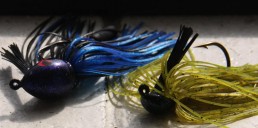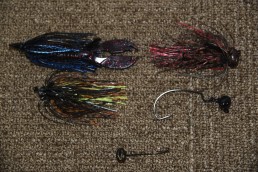Three Bass Jigs You Must Have, and How to Use Them
SHARE THIS POST
No one can dispute that big bass bite jigs. The rubber-skirted jigs are categorized into three distinct styles: flipping, football and finesse. To the untrained eye, they’re identical, but their intricacies make them uniquely different.
Flipping jigs
Flipping jigs are the bread and butter of any bass nut. Poured with a stout hook and fiber weed guard, these are meant to penetrate cover. Ranging from 1/4 ounce to the magnum 1 1/2-ounce beasts, they’re designed for war regardless of how gnarly the cover is. Teamed with heavy lines and heavier rod actions, they’re a standard.
Keen anglers must focus on jig head design, as missing any minor detail can become a headache on the water. Cone-shaped heads excel in weeds. The line tie should be no greater than 60 degrees and the lead needs to mold seamlessly with the hook eye. Any flaw will catch more weeds than bass. Being picky will have you fishing more and cleaning less. And if you’re targeting wood, select a jig head with a rounder or triangular shape, as this design glides over limbs easily. A wider head also positions the hook up; a slimmer head tends to allow the hook to fall on its side and dig into the wood as it’s pulled through branches.
A neat presentation is swimming a jig. Using a grass jig—at 1/4, 5/16 or up to 3/8 ounce—and floating the bait over cover much like a shallow crankbait with a slow, steady retrieve while pulsing and giggling the rod tip to keep the jig lively, will catch more. This method transforms the jig into a fleeing baitfish so colors should match the local baits. A few strands of orange, green, white, light blue or gray will work wonders. Don’t dismiss an all-white jig and trailer either, as it’s a great baitfish mimic.
A recent trend has been the giant jig—real big boys up to 1 1/2 ounces. From inches of water to the deepest weed beds, jigging mats is a sure-fire method to nail the biggest bass, but it is very labor intensive. This requires long, heavy-action rods and the heaviest braided line. You’ll feel like you’re equipped for war. Lighter jigs lack the momentum to pierce heavy, canopied weeds, so stick to be heaviest ones.
Are you enjoying this post?
You can be among the first to get the latest info on where to go, what to use and how to use it!
Football jigs
Football jigs, a close cousin to flipping, were designed specifically for bouncing along deep rocky bottoms. The major difference is its chubby football-shaped head with the line tie from 90 to 60 degrees. This design won’t wedge between boulders and is surprisingly good in thin vegetation. Most football jigs are heavy at 1/2 to 1 ounce, so they’re ideal for staying on the bottom. Strikes typically occur at the end of long casts so solid hook-sets can be a challenge. Make sure the jig has an ultra-sharp hook and thinned weed guard.
Football jigs are best worked around deep grass lines, bluff banks, bars, points or saddle areas between islands. Surprisingly, this technique is a quick and easy way to check expansive areas, vacuuming up the aggressive biters, yet enticing to the fickle ones. Bomb the cast over the structure, wait until it hits the bottom and work it along. Fish footballs more like crankbaits than traditional jigs. Dragging these with sweeping rod pulls or crawling it under a leisurely retrieve will mimic crayfish perfectly. Stick to a twin-tail grub or frog chuck trailer. Olive, melon, pumpkin, peanut butter and jam, or craw colors are best.
Mini-jigs
Finesse mini-jigs are a junior version of a flipping jig. These bite-sized baits are ideal in a multitude of fishing conditions. Ultra-shallow, clear water, in heavy fishing pressure, during cold fronts or in colder water, are all perfect mini-jig situations. Most finesse jigs have a thin wire hook, making them an ideal match for spinning or scaled-down casting gear. Regular jig hooks usually are as tough as nails, but a thinner gauge hook may fold under pressure, and added care might be needed when trying to pull bass from cover.
In high-stakes tournaments, mini-jigs have secretly flowed through the ranks of the elite; big weights and top finishes speak volumes. Some anglers have literally turned their tournament careers around solely on the success of mini-jigs. This is not a fad, and much of it does have roots in scientific research. Immature crayfish flee the shallows to escape scores of predators, particularly rock bass, their first year of life. Bass living along deeper structure are accustomed to feeding on smaller crayfish, making tinier jigs an ideal match.
Compact sizes don’t always translate to lighter weights. A few companies pour finesse jigs up to 1/2 ounce, but they’re a rare find. These skilled manufacturers shrewdly manipulated the lead head to remain minuscule yet heavy. Others have switched to tungsten, a pricy lead alternative. Regardless, mini-jigs can transform a day on the water from ho-hum to amazing. Also, jigs are core bass tackle. For more success, throw them often and fine-tune your approach to find which type of jig will be best for the area you’re fishing in.
MWO
SHARE THIS POST
Did you enjoy this post?
You can be among the first to get the latest info on where to go, what to use and how to use it!
Luigi De Rose
Luigi De Rose, has been crafting articles for the last 25 years. Loving anything fishing, especially bass fishing, Luigi has been lucky enough to fish on three continents. Currently, he is the bass editor at Ontario OUT of DOORS magazine and owner of IBASSIN.com, a blog decided to all things bass. His articles have graced the pages of Bassmaster, In-Fisherman and MidWest Outdoors to name a few. When not fishing, you can find him with his two girls and wife in the outdoors.



